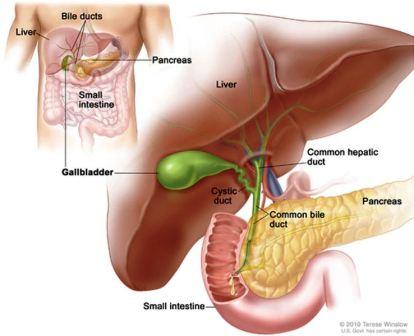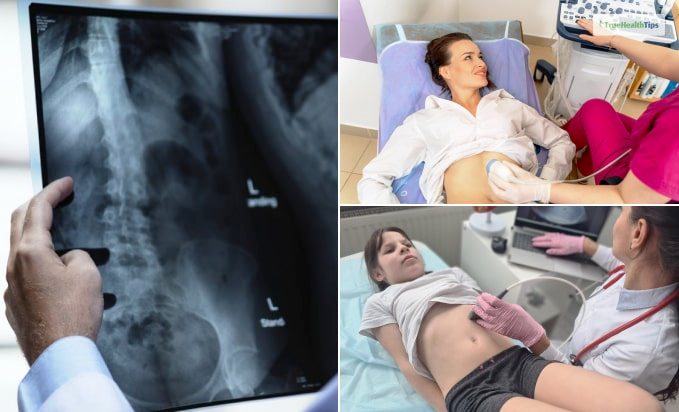The gallbladder is a small, pear-shaped organ located beneath the liver. It plays a crucial role in the digestive system by storing and releasing bile. In addition, it is a digestive fluid that aids in the breakdown of fats. While the gallbladder may be small in size, it holds a significant place in our health. In this comprehensive article, we will explore how much does a gallbladder weigh, its functions, its location in the human body, common diseases, diagnosis methods, and tips for maintaining its health.
Gallbladder Location in the Human Body
The gallbladder is situated in the upper-right belly region, next to the liver. It is located close to the ribcage, against the underside of the liver. Its ability to store and release bile, which the liver produces and transports to the gallbladder for storage until it is required for digestion, depends on its proximity to the liver.

How much does a gallbladder weigh?
The gallbladder is a small, pear-shaped organ responsible for storing bile produced by the liver. To understand its importance in the human body, one must be aware of its average weight. A healthy gallbladder normally weighs between 30 and 50 grams on average.
How much does a gallbladder weigh in ounces?
You may wonder how much a gallbladder weighs on average. The weight of a healthy gallbladder can vary from person to person. The average weight of a healthy gallbladder typically falls in the range of 30 to 50 grams. To put this into perspective, this is roughly equivalent to 1 to 2 ounces.
How Much Does a Gallbladder Removal Cost in the USA?
- Laparoscopic Cholecystectomy: This minimally surgical procedure is the most common method for gallbladder removal. It typically involves smaller incisions, shorter hospital stays, and faster recovery. The cost of a laparoscopic cholecystectomy without insurance can range from $10,000 to $20,000 or more, depending on various factors.
- Open Cholecystectomy: In cases where laparoscopic surgery is not feasible due to complications or specific medical conditions, an open cholecystectomy may be performed. This traditional surgery involves a larger incision and a longer recovery period. The cost can be higher, ranging from $15,000 to $30,000 or more.
Gallbladder Functions in the Human Body
Understanding the functions of the gallbladder is crucial for appreciating its role in the digestive system. The gallbladder’s primary function is to store bile, a digestive fluid produced by the liver.
A meal high in fat causes the gallbladder to constrict and discharge stored bile into the small intestine. Since it blends fats and fragments them into smaller pieces, bile is necessary for the digestion of fatty acids. The body can absorb the necessary nutrients and acids may operate on lipids more easily as a result of this process.
In summary, the gallbladder helps with the digestion and absorption of dietary fats by storing and releasing bile.
Factors Influencing Gallbladder Weight
Several factors can influence the weight of the gallbladder:
Age and Gender
Our organs, especially the gallbladder, might change as we get older. Gallstones, which can impact the weight of the gallbladder, are more likely to form in older people. Additionally, studies indicate that women may be more likely to develop gallstones, which could affect the size of their gallbladders.
Gallbladder Diseases
Changes in the gallbladder’s weight can be caused by a number of gallbladder illnesses, including cholecystitis (gallbladder inflammation) and cholelithiasis (gallstone development). Gallstones can occasionally cause the organ to gain weight as a result of their buildup.
Body Weight and Composition
The size of the gallbladder might also depend on body weight and composition. Eating or being overweight has been linked to an increased risk of gallstones and may also have an impact on the gallbladder’s weight, according to research.
Gallbladder Diagnosis
The following are several gallbladder size tests to identify gallbladder issues and diseases:

Belly-Scan Ultrasound
Abdominal ultrasound, commonly referred to as belly-scan ultrasound, is a non-invasive imaging procedure frequently used to evaluate the health of the gallbladder. The size, shape, and existence of gallstones or other abnormalities in the gallbladder were all assessed using this technique after images were taken by a technician or radiologist. This diagnostic technique is useful for identifying common gallbladder problems and informing subsequent treatment choices.
Hida Test (Cholescintigraphy)
It is a nuclear medicine-based test. An intravenous injection of a radioactive tracer causes bile ejection. Healthcare practitioners can assess the gallbladder’s health by keeping track of how quickly it releases bile. The Hida test is very helpful in identifying gallbladder diseases caused by reduced movement or empty.
Endoscopic Retrograde Cholangiopancreatography (ERCP)
It is a nuclear medicine test. Bile secretion is brought on by an intravenous infusion of a radioactive tracer. It includes inserting an endoscope, a flexible tube with a camera and light, down the esophagus and into the duodenum (the first section of the small intestine), through the mouth.
This makes it possible for the medical professional to spot clogs, gallstones, or other problems in the gallbladder and related ducts. ERCP has both diagnostic and therapeutic uses, including the removal of gallstones and the implantation of tubes to relieve blockages.
Magnetic Resonance Cholangiopancreatography (MRCP)
With the help of MRCP, the gallbladder and bile ducts can be seen clearly without the use of contrast agents or invasive procedures. Magnetic resonance imaging (MRI) technology is used in MRCP to produce incredibly fine images of the biliary system. The patient is inside an MRI machine during the operation, which produces images by using radio waves and powerful magnetic fields. For patients who are unable to endure operations that call for contrast chemicals, this technique is especially helpful.
Ultrasound With Endoscopy
The combination of endoscopy with ultrasound is a diagnostic strategy that provides a thorough image of the gallbladder and nearby structures. A typical procedure involves two steps: first, a flexible tube called an endoscope is inserted via the mouth and into the duodenum and stomach. The end of the endoscope has a camera on it. Using this combination the condition of the gallbladder and its relationship to other organs and ducts are comprehensively assessed.
Abdominal X-Ray
Gallstones appear as bright or shadowy patches on the X-ray image because they are thick and can block X-rays. Compared to other imaging methods, abdominal X-rays are often less precise and may not always offer a conclusive diagnosis. However, they can be a helpful first step in the diagnosis of gallbladder problems.
Gallbladder Diseases
Now, let’s explore common gallbladder diseases, their symptoms, and potential complications in more detail:
Gallstones
Gallstones are small deposits that form within the gallbladder. They can range in size from tiny grains of sand to larger stones. Gallstones are a prevalent gallbladder condition and can cause significant health issues.
Symptoms: Gallstones can lead to symptoms such as severe abdominal pain, often referred to as biliary colic, which occurs when a stone blocks the flow of bile. Other symptoms include nausea, vomiting, and indigestion.
Complications: If gallstones obstruct the common bile duct or the pancreatic duct. It can lead to more severe complications, such as jaundice (yellowing of the skin and eyes) and pancreatitis.
Choledocholithiasis
Choledocholithiasis occurs when gallstones move from the gallbladder into the common bile duct. This can obstruct the normal flow of bile from the liver to the small intestine.
Symptoms: Common symptoms include abdominal pain, jaundice, and in some cases, infection due to bile duct blockage.
Complications: Left untreated, choledocholithiasis can lead to severe infections, cholangitis, and pancreatitis.
Cholecystitis
Cholecystitis is the inflammation of the gallbladder, often trigger by gallstones blocking the gallbladder’s neck or cystic duct.
Symptoms: Symptoms of cholecystitis include severe abdominal pain, typically in the upper-right quadrant, fever, and nausea.
Complications: If not treated promptly, cholecystitis can lead to gangrene, abscess formation, or the rupture of the gallbladder, which can be life-threatening.
Gallbladder Abscess
A gallbladder abscess is a localized collection of pus within the gallbladder. It frequently goes hand in hand with severe illness or inflammation.
Symptoms: The symptoms of a gallbladder abscess may include persistent, intense abdominal pain, fever, chills, and jaundice if the condition is obstructing the bile ducts.
Complications: If not treated promptly, a gallbladder abscess can lead to more extensive infection or rupture, posing a significant health risk.
How to Keep Your Gallbladder Healthy and Prevent Gallbladder Stones
Maintaining gallbladder health is essential to prevent the formation of gallstones and other gallbladder-related issues. Here are some tips to help you keep your gallbladder healthy:
- Balanced Diet: Consume a diet that is low in saturated fats and cholesterol. Incorporate fiber-rich foods like fruits, vegetables, and whole grains to promote healthy digestion.
- Stay Hydrated: Drinking plenty of water helps maintain the flow of bile and prevents the concentration of bile that can lead to stone formation.
- Portion Control: Overeating can put stress on the gallbladder. Practice portion control to avoid overloading your digestive system.
- Regular Physical Activity: Exercise regularly to maintain a healthy weight and reduce the risk of gallstones.
- Avoid Rapid Weight Loss: Rapid weight loss, such as crash diets, can increase the risk of gallstone formation. Aim for gradual and sustainable weight loss.
- Limit Alcohol and Sugar: Excessive alcohol consumption and high sugar intake can contribute to gallstone formation. Moderation is key.
- Consult Your Doctor: If you have a family history of gallbladder issues or are at risk. So, consult your doctor for regular check-ups and personalized advice.
Visit Us Regularly: www.truthsfirst.com
FAQ
How much weight do you typically lose after gallbladder surgery?
What is the usual weight loss following gallbladder removal surgery? Due to: Cutting out fatty foods, you’ll probably lose an average of 130 pounds after surgery.
What is the actual size of a human gallbladder?
With an average volume of 30 to 50 mL, the gallbladder is a pear-shaped sac that is roughly 7 to 10 cm long and 4 cm wide.
Does removing gallbladder make you lose weight?
It is possible to lose weight after gallbladder surgery because it is one of the side effects. Your health will depend on rapid weight loss or short-term weight loss plans.
How is life after gallbladder removal?
Without a gallbladder, you can still live a perfectly normal existence. To digest your food, your liver will still produce adequate bile.
